Fundraising Dashboards: A Beginner’s Guide
What is a fundraising dashboard?
Small organizations often struggle with tracking and analyzing key fundraising data. Dashboards are important as they have the ability to efficiently access crucial fundraising data, interpret it, and help you to assess your organization’s performance.
A fundraising dashboard takes the data that you collect, and helps your team to visualize it, and see areas of possible improvement, or opportunities. Since they offer a condensed summary, or snapshot, of all fundraising activities up to the current date, dashboards are an excellent resource for keeping board members informed about the organization's fundraising progress. This way, they can have a clear understanding of where the organization stands and make informed decisions about its future.
Why are fundraising dashboards important?
Dashboards display key performance indicators, guiding fundraising strategies and enhancing decision-making. Instead of each person producing their own reports and trying to analyze their donor data, they encourage open communication among your organization’s entire team by visualizing your fundraising progress. With centralized data, it's easier to analyze trends and take action. For instance, a pattern might emerge showing increased donations at year-end, followed by a significant drop. Dashboards summarize your data and provide a complete overview of your team's fundraising efforts.
What are components of an effective fundraising dashboard?
Dashboards typically use a combination of visuals such as tables and charts to help you not only with your analysis, but to effectively communicate your findings to your team so they can easily understand your fundraising progress.
Furthermore, you can often tailor what information you see, and modify the information displayed based on your needs. For instance, you might want to view data on a monthly or yearly basis. This adaptability makes the dashboard a versatile tool for tracking your fundraising goals.
And finally one of the most important components of a dashboard is they are user-friendly. Dashboards are designed to be straightforward and easy to understand. This means you should not need extensive training to use them. Their simplicity and ease of use make them an essential tool in fundraising and data analysis.
Creating a fundraising dashboard
When it comes to fundraising dashboards, choosing to create one from scratch or opting for a donor software that has a built-in dashboard is not always an easy decision. There are many factors to consider. By weighing the pros and cons of each option, you'll be better equipped to make an informed choice.
The first option is to build your own dashboard from scratch. If your team decides to build your own dashboard, you have complete control over the data that you want to visualize. Your team can decide exactly which data you would like to track, and which charts and graphs work best for your team. However, dashboards can take a lot of time to build and you must consider your team’s capacity, and resources. Also, you will need to consider how often you will update the data, and how you will secure your donor data. In addition, if your team does not have a member with expertise on how to build a dashboard, you may need to consider a professional development budget to train someone on how to create one.
On the other hand you can use an existing software. There are many options for donor management software, and many include pre-built dashboards to help your team. With software the vendors are in charge of updating the software, and keeping the data secure. And often pre-built dashboards are easy to use and require no initial setup other than entering your fundraising data. Even so, an existing product may lack the flexibility that your team needs, and you may not have control over which data you would like to see and how you would like your data to be displayed.
When deciding over creating it yourself and using a software with a pre-built option you will need to consider your organization’s requirements, resources and most importantly your long-term fundraising goals.
How to use a fundraising dashboard
To use your dashboard, it is important to identify which members of your team will be responsible for monitoring it. For smaller teams, or solo operations, this responsibility may fall on a single individual. However, in larger teams, it could be beneficial to assign one person to manage the dashboard, with another to assist and provide backup. Additionally, you will need to consider how frequently you will review your dashboard. Annually tends to work for most, but if resources permit, you could try reviewing quarterly or even monthly. Find a cadence that works for your team as this will ensure your team stays on track and makes adjustments as necessary to meet your fundraising objectives.
Donor dashboards are powerful tools that help nonprofits make data-driven decisions. They can identify what is working well in the organization, and where there is room for improvement in your fundraising strategy. This information is useful for guiding the direction of fundraising efforts, helping to ensure goals are met. Furthermore, dashboards can make complex data easy to understand, enabling nonprofits to steer their fundraising strategies effectively.




